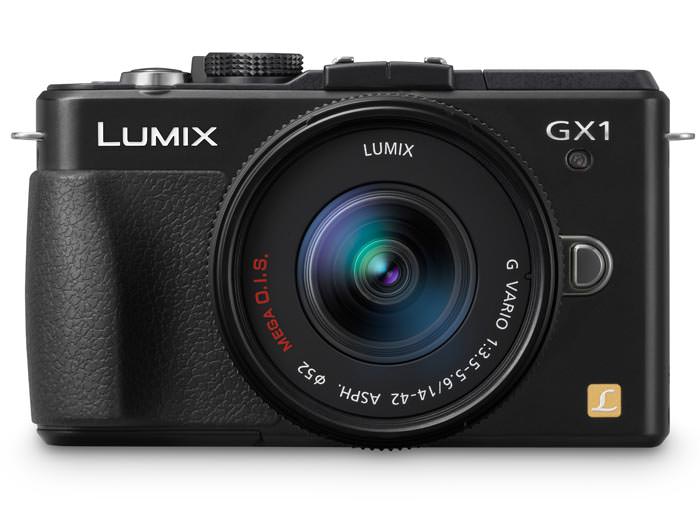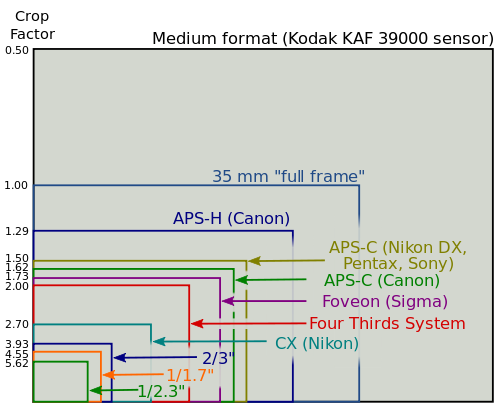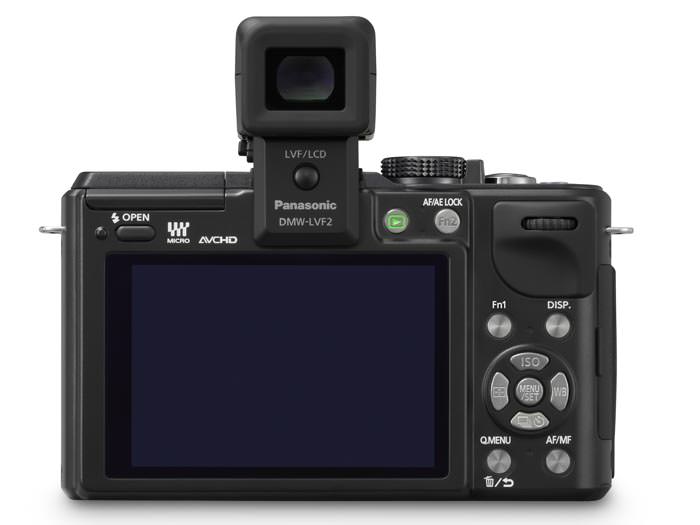How To Fix Evf Distortion Panasonic Gx Camera
I recently had the opportunity to spend some time with the Panasonic GX1. Although I have endemic some compact cameras and occasionally have the take a chance to experiment with those of others, this is the outset mirrorless camera I have used. As Nasim and others accept indicated, mirrorless cameras volition increasingly play a larger office in the digital camera marketplace, due primarily to their smaller size, lighter weight, reduced mechanical complexity, and faster FPS ( frames per 2d speed). They provide an impressive range of features in extremely minor packages. But mirrorless cameras such as the GX1 still correspond a modest investment and thus do not offer any cost reduction relative to entry and mid-level DSLRs. In this Panasonic GX1 Review, I will provide detailed information about the camera, likewise every bit prototype comparisons to other DSLR cameras.

Some of my questions prior to receiving my GX1 included:
- How well would the GX1's picture quality compare against that of my D7000?
- How well would the GX1's pictures compare to my D800?
- Would I detect the weight advantage of the GX1 meaningful?
- How would I arrange to the GX1's controls?
- What would cause me to consider a GX1 over a DSLR or indicate-and-shoot camera?
Panasonic Lumix GX1 Specifications
- Lens Mount: Micro Four Thirds
- Camera Format: Micro Iv Thirds (2x Crop Factor)
- Resolution: 16 Megapixels
- Sensor Type / Size: MOS, 17.3 ten 13.0 mm
- File Formats: However Images: JPEG, RAW
- Movies: MPEG-4 AVC/H.264, MOV
- Memory Menu Type: SD, SDHC, and SDXC
- Epitome Stabilization: Optical
- Video Recording: Yes, Aspect Ratio: one:1, three:ii, iv:iii, xvi:ix
- Focus Type: Auto & Manual
- Focus Mode: Single-servo AF (S), Continuous-servo AF (C), Transmission Focus (G) , Focus Lock AF Area Way
- Autofocus Points: 23
- Brandish Screen: 3.0″ Touchscreen LCD (460000)
- ISO Sensitivity: Auto, 160-12800
- Shutter: ane/4000 – 60 seconds
- Remote Control: DMW-RSL1 (Optional)
- Metering Method: Spot metering, Center-weighted boilerplate metering
- Exposure Modes: Aperture Priority, Auto, Manual, Programme, Shutter Priority
- Compensation: -five EV to +five EV
- White Residuum Modes: Auto, Cloudy, Daylight, Flash, Incandescent
- Built-in Flash: Yes (Auto, Motorcar/Cherry-heart Reduction, Flash On w/ Cerise-center Reduction, Forced On, Off, Boring Sync, Slow Sync./Blood-red-middle Reduction)
- Continuous Shooting: Upwardly to xx fps
- Connectivity: ane/8″ Microphone, AV Output, HDMI C (Mini), USB ii.0
- Bombardment: 1x Congenital-in Rechargeable Lithium-ion Bombardment, seven.2VDC, 1010mAh
- Physical Dimensions (WxHxD): iv.58 10 2.67 x 1.55″ / 116.iii x 67.8 x 39.4 mm
- Weight: 11.22 oz / 318 k
Lenses
My unit included the body and GX Vario PZ fourteen-24mm (FX equivalent 28-48mm) f/three.v-v.6 ($659 at B&H) and the GX Vario PZ 45-175mm f4-five.6 OIS ($339 at B&H) lenses (FX equivalent 90-350mm). Although not very fast lenses, these 2 lenses offered quite a bit of range in very compact packages. I may be exaggerating (just a chip), but I doubtable both of these lenses together weighed less than one of my Nikon 77mm lens caps!

Sensor
The original Four Thirds sensor is well known and widely used in Panasonic and Olympus digital cameras. The GX1 uses the Micro Four Third sensor, which is an adaptation of the Four Thirds sensor for mirrorless cameras. Like its predecessor, the Micro Four Third sensor also has a 2X crop cistron. You can read many reviews of the Four Thirds sensor. My purpose was rather to determine how the photographic camera performed rather than repeat the same sensor-related tests performed by others.

(Image courtesy of Wikipedia)
Camera construction and handling
The GX1 has a sleek design and the feel of a very well-made production. It is obvious that Panasonic did its homework in building a mirrorless photographic camera that would easily pass the aesthetics test. The classy gun metal gray aluminum trunk and textured rubber grip were extremely like shooting fish in a barrel to hold, despite the fact that I take larger hands. I received my GX1 the day before my wife, Tanya, and I headed off to our vacation in Canmore, Canada. My unit of measurement had the silver finish, but I think the black terminate is a flake sharper looking. Equally I packed our gear, including a 40+lb backpack that included my D800, infrared-converted D900, and a slew of lenses and accessories, ane aspect of the GX1 really stood out – it's weight!
Given my normal paranoia regarding the possibility of forgetting something while packing, I have to admit that on more than one occasion, I opened the GX1'south camera bag to ensure that it and the lenses were actually in the bag. It was then lite compared to the other items I was treatment that the bag felt empty! My married woman and I quickly decided upon a nickname for the GX1 as we prepared for our trip – "Aircam." After that, neither of usa used the term GX1 once more.
Photographic camera Carte du jour System
Although I am used to the Nikon DSLR menu organization, I have seen my share of the point-and-shoot cameras. I found the GX1 carte system to be fairly like to other cameras in its category. The impact screen is a nice addition, and easy to become used to. I didn't do a deep dive of the menu organization, notwithstanding, choosing to observe and modify those items as I needed. Some people have the notion that point-and-shoot and mirrorless cameras are "simpler" to utilise than entry or mid-level DSLRs. That has not been my experience. The scene modes that be in each of these technologies level the playing field quite a flake. After turning on the GX1's self-timer, I had a heck of a time determining how to turn it off. I eventually had to go online and do some searching before finally coming across a forum where a number of people had expressed the same business organization, and provided some instructions for dealing with this upshot.
Features and Responsiveness
I handed the GX1 to my married woman, Tanya, during our holiday. While not sharing my enthusiasm for photography, Tanya agreed to experiment with the GX1 and take multifariousness of exam shots on our vacation. Later on receiving some extremely limited instructions, she was quickly taking some very squeamish photos with the GX1, while I focused on testing my new (and properly focusing!) D800. She had a much easier fourth dimension taking abrupt photos with the GX1 than she did with my D800, as fifty-fifty with VR lenses, the D800 and lens combo proved a chip also heavy for her to handle. She had no such issues with the GX1.

Sometimes the testimony to the user friendliness of whatever piece of technology is not how an experienced person adapts to information technology, simply rather how someone not well-versed in the technology tin decide how to use information technology finer in real world conditions. I accept to say that the GX1 proved very capable and easy to use in the field. Neither Tanya nor I had whatsoever difficulties using information technology, despite a rather accelerated learning curve. Of form, with beautiful sunshine on nearly every day of our vacation, the GX1 was operating under the best possible atmospheric condition.
Like many other mirrorless, point-and-shoot cameras, and cell phone cameras, the GX1 does not have a viewfinder congenital into the unit. In my opinion, the lack of a viewfinder, on any camera other than a cell phone, is a serious flaw. In bright conditions, it is extremely difficult to focus with the LCD. And depending on your eyesight, it can be also be a chip catchy to compose your photos with any degree of accuracy, particularly if yous demand bifocals and have to adjust the length of the photographic camera from your eye. The other business is that the lack of a viewfinder requires you to agree the GX1 12 to xviii inches away from your torso, thus increasing camera shake and boosting the ISO to maintain a reasonable shutter speed, in anything other than perfect lighting weather condition.
You can buy an optional electronic viewfinder (EVF), the DMW-LVF2, which will add another $159 to the toll tag. The adept news is that this EVF can provide the same perspective equally a full frame DSLR viewfinder. The downside is that EVF technology can yield artificial looking scenes, with effects that mimic chromatic aberration or halos. EVFs can besides have a bit of a lag relative to the manual of the image to the EVF, thus yous may be taking a photo of a scene that has inverse by the time you press the shutter. Using the GX1 with the DMW-LVF2 is certainly an improvement over of relying on the LCD, but EVF technology yet has a means to get before it can truly rival the quality of optical viewfinders.
Autofocus, Metering, And Dynamic Range
The GX1 never failed to quickly acquire an accurate focus. I was pleasantly surprised at how quickly information technology responded in the field. I didn't have the opportunity to shoot any fast activeness sports shots, notwithstanding, merely then again, cameras in this class are not meant to exist speed demons on the AF front. Sophisticated AF systems are normally plant on higher end DSLRs and require higher terminate lenses to maximize their capabilities.
Comparing the RAW files of the GX1 and my D7000, I had a difficult time noticing any differences between highlights and shadows produced by each. Regarding the Automatic White Balance setting, the GX1 photos seemed to skew slightly toward the magenta side, while the D7000 photos had a hue more toward the yellow end of the color spectrum. Afterward looking at files produced by each for some fourth dimension, I could easily determine which photo was taken by each camera by examining the white balance. I institute the GX1'south white balance setting to be more accurate than that of my D7000.
Epitome Sharpness
The D7000, combined with the Sigma 17-50mm f/2.viii, created slightly sharper images than the GX1 and its GX Vario PZ 14-42mm lens. I had to zoom in quite a bit to notice the deviation however, and suspect that unless you were pixel peeping or printing beyond 8X10, you might never notice a deviation. This may exist a bit of an unfair comparing considering that the Sigma 17-50mm is an extremely abrupt lens and sells for $669. With the D7000 added to the bill, yous are looking at $one,666, compared to the $659 for the GX1 and GX Vario PZ 14-42mm lens.
The 45-175mm lens proved to be quite sharp, even on the long finish (350mm FX equivalent) – extremely impressive for such a tiny lens that weighs slightly over 7 ounces.
Movie Recording
I captured a few movie clips which seemed to be quite sharp and smooth during playback. I don't claim to existence a video afficianado however, and don't have much of a footing by which to compare the GX1 to other digital cameras. From the specs, the GX1 seems to concord up fine compared to digital cameras in its class. Hither is a an example of the GX1'south video capabilities (not my video).
OK – Can Nosotros Finally Come across Some Images Comparisons?
Someone has to be asking this question by now! I have posted a few pictures below. I will warn you that even amongst some of the Photography Life team, some have gotten them wrong.
D800, GX1 & Samsung Galaxy S Iii
Which is which?



Examining Center Crops
Can you lot tell which is which now?



Notation: Run into answers at the bottom of the article
GX1 vs. D800
The GX1 and D800 comparison is certainly not a fair one, but I was pleasantly surprised how well the GX1 managed a very tricky lighting situation associated with the photo below. The D800 photo is a slightly dissimilar scene, but the challenging lighting conditions are similar.


GX1 vs. D7000
I decided to compare the GX1 to my D7000, since they have equivalent-sized sensors. A comparison between the GX1 and the Nikon D3100 or D5100 would probable have yielded similar results considering the size and quality of their sensors. And despite its depression cost, the Nikon 18-55mm VR lens is extremely abrupt.














As you tin see, the GX1 turns in pretty respectable performance compared to the D7000/Sigma 17-50mm f/2.viii combination.
Ownership Considerations
The Case For The GX1
The overwhelming case to be fabricated for a GX1 involves its diminutive size and weight and its ability to take loftier quality photos and videos – information technology is not necessarily cost (as you shall soon see) or simplicity of use.
I have e'er been a bit surprised at how many people complain well-nigh the size and weight of DSLRs, merely occasionally sympathise such sentiments after a long day of lugging ii DSLRS around my cervix plus a backpack containing 20-40lbs of additional gear! If you lot endure from neck or back issues, even a small DSLR and lens may seem similar a burden you would just as soon non accept to deal with. I would strongly urge anyone considering the GX1 to purchase the optional EVF. It is a must for sunny days and for those that rely on bifocals.

For frequent travelers seeking to maximize the quality of their photos while existence mindful of luggage space and weight concerns, a compact mirrorless camera, such as the GX1, is a more applied alternative to a DSLR. I would be remiss if I did not mention the Canon S90, S95, and S100. And while not matching the features of the GX1, these miniature Canons are tough to beat out if "modest, light, and affordable" are your priorities.
What if you wanted to stay in the mirrorless camp but look at other alternatives? There are many out in that location and probably quite a few more in the pipeline. The Sony NEX-5N with its 18-55mm kit lens ($698), Sony electronic viewfinder ($259), and additional Sony 55-210mm zoom lens ($348) would cost you $one,305 – a bit higher than the GX1 package, but still inside reach financially. Every bit Nasim's Sony NEX-5 review revealed, is a very capable camera and stacks up well against the GX1.
Applied DSLR Alternatives To GX1 Configuration
Ok, so what if size and weight aren't at the pinnacle of your criteria list and y'all still want loftier quality photos? This is where it gets tricky. In that location are a variety of entry and mid-level DSLR configurations to achieve the same focal length equally the GX1 configuration I have described, and can be had for a similar, if not lower, price.
The GX1 configuration ($659 – GX1 & fourteen-42mm GX Vario PZ Lens, $339 – 45-175mm lens) I received cost $998. As I mentioned, I wouldn't think of relying on the GX1 without purchasing the additional electronic viewfinder for $160. That would bring the total cost to $1,158.
You could relieve $210 by going with the GX1 configured with the "Thou" 14-42mm lens. This cheaper alternative lens is a flake larger than its higher priced cousin. The price of the lower finish GX1 configuration is $957 ($469 – GX1 & 14-42mm Vario Lens, $339 – 45-175mm lens, $159 EVF).
You take some other options necessary to achieve the similar focal length reach (slightly less – the 55-200mm below represents an 82.5-300mm FX equivalent). Here are the Nikon DSLR configurations that are within the ballpark of either the loftier/depression end GX1 configurations:
D3100 Bundle – With eighteen-55mm VR& 55-200mm VR lenses
Full – $646
D5100 Bundle – With eighteen-55mm VR & 55-200mm VR lenses
Total – $846
If yous picked up either a new or used 18-200mm VRII lens, and sell the 18-55mm VR kit lens, you could also go within striking altitude of the higher end GX1 configuration, and have a one-lens solution. Keeping the 18-55mm VR kit lens and ownership a used 70-300mm VR lens would also get you close as well. I suspect you could notice similarly-priced configurations for Catechism as well.
Keeping the eighteen-55mm VR kit lens and buying a used seventy-300mm VR lens would also get you lot shut GX1's price. Once once more, you lot could configure a similarly equipped Catechism and be in the aforementioned price range.
Summary
The GX1 is a very well congenital, stylish, and capable photographic camera. I have to admit, all the same, that I struggled a scrap with the "Value" ranking. If size and weight, along with top-notch image quality, are critical factors selecting a digital camera, the GX1 represents a solid mirrorless contender and definitely worthy of your consideration. Otherwise, cameras such as the Nikon D3100 or D5100 (or their counterparts from other DSLR manufacturers) and a multifariousness of lens combinations represent affordable alternatives, more flexibility for growth, and improve value.
Answers to "Which is Which" to a higher place: Photo 1 – D800, Photo ii – GX1, Photo 3 – Samsung Milky way 3
Panasonic GX1
- Optical Performance
- Features
- Build Quality
- Focus Speed and Accuracy
- Handling
- Image Stabilization
- Value
- Image Quality
- Loftier ISO Performance
- Size and Weight
- Metering and Exposure
- Dynamic Range
Photography Life Overall Rating

Source: https://photographylife.com/reviews/panasonic-gx1
Posted by: petersacal1959.blogspot.com

0 Response to "How To Fix Evf Distortion Panasonic Gx Camera"
Post a Comment